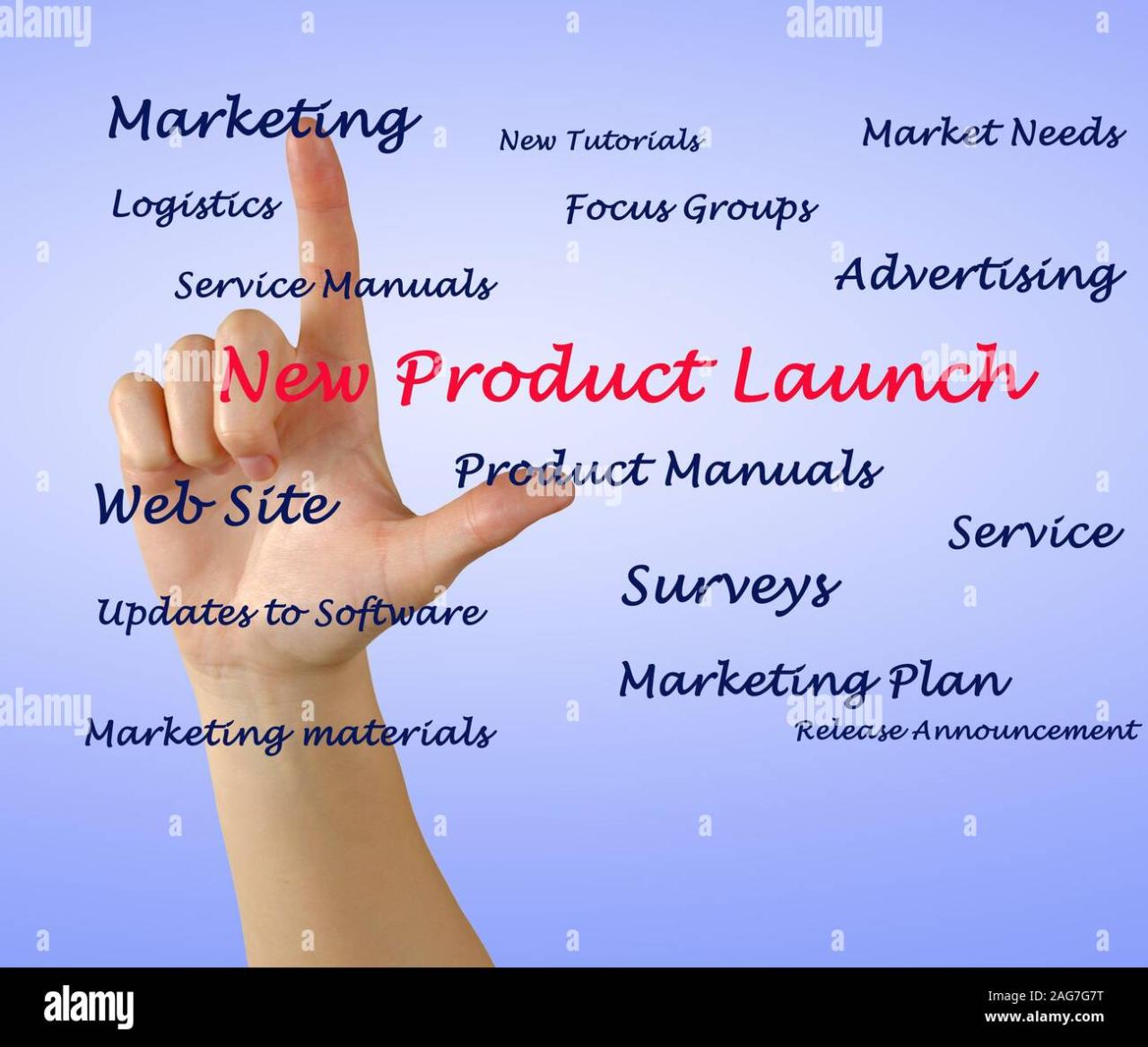
New Product Launch A Comprehensive Guide
New product lauch – New product launch sets the stage for a thrilling journey from concept to market. We’ll explore the entire process, from meticulous product development to engaging marketing strategies and successful post-launch analysis. This detailed guide will help you navigate the intricacies of bringing a new product to life, considering factors like market research, competitive analysis, and effective sales strategies.
This guide will walk you through the entire lifecycle of a new product, covering the pre-launch activities, product features and benefits, and the critical steps for a successful launch. We’ll also delve into how to analyze the launch’s success, make necessary adjustments, and use the data for future product development.
Product Development Lifecycle

Launching a new product is a complex process, often requiring careful planning and execution across various stages. From initial concept to final market entry, each step is crucial to the product’s success. Understanding the nuances of the product development lifecycle is paramount to navigating the challenges and maximizing the potential of a new offering.The product development lifecycle (PDLC) encompasses a series of interconnected stages, each with specific tasks and timelines.
Effective management of these stages, while considering market dynamics and competitor actions, is essential for a successful product launch. The lifecycle begins with ideation and culminates in market entry, and each phase impacts the overall success of the product.
Stages in the Product Development Lifecycle
Understanding the sequence of stages in the PDLC is crucial for successful product launch planning. Each stage plays a critical role in the product’s development and ultimate market reception.
- Ideation and Concept Development: This initial phase focuses on generating and evaluating potential product ideas. Market research, competitor analysis, and customer feedback are crucial to refining the concept and ensuring its viability. This stage typically takes several weeks to a few months, depending on the complexity of the product and the depth of research required. For example, a new software application might involve user interviews and prototype testing before the final concept is approved.
- Market Research and Analysis: Thorough market research is essential to validate the product concept and understand the target audience’s needs and preferences. This phase typically includes market sizing, competitor analysis, and customer segmentation. It helps in determining the product’s potential and shaping the development roadmap accordingly. This stage often takes a few weeks to several months, depending on the complexity of the market and the scope of the research.
- Product Design and Development: This phase involves the actual design and development of the product, including prototyping, testing, and refinement. The timeline for this stage depends heavily on the product’s complexity. For example, a simple physical product might take a few months, while a complex software application could take several months or even years.
- Testing and Validation: Rigorous testing is crucial to ensure the product meets quality standards and user expectations. This phase includes beta testing with potential customers and performance testing in different environments. The length of this stage is variable, but it’s critical to identify and fix potential issues before the product launch.
- Marketing and Sales Strategy: This stage involves developing the marketing and sales strategies to effectively position and promote the product to the target audience. This phase includes defining the target market, setting pricing strategies, and developing a go-to-market plan. The timeline depends on the complexity of the marketing campaign and the resources allocated.
- Product Launch and Post-Launch Evaluation: The launch phase involves the actual introduction of the product to the market. The subsequent post-launch evaluation measures the product’s performance and gathers feedback to refine future iterations. This phase involves continuous monitoring of sales, customer feedback, and market trends to adjust the strategy as needed.
Product Launch Strategies
Different product launch strategies can significantly impact the product’s initial reception and market penetration. The chosen strategy should align with the product type, target audience, and overall business goals.
- Phased Rollout: This strategy involves launching the product in specific geographic regions or to specific segments of the target market. It allows for gradual market testing and adjustment of the product based on initial feedback. This is suitable for products with a wide target audience or those needing adjustments based on market response.
- Simultaneous Launch: This strategy involves launching the product globally or in all targeted markets at the same time. This approach is often chosen for products with strong brand recognition or those needing immediate market penetration. For example, a company might simultaneously launch a new smartphone model in all major markets.
Market Research and Product Development
Market research provides valuable insights into consumer preferences, market trends, and competitor activities. This data informs product development decisions and launch strategies. Effective market research helps tailor the product to meet specific market needs and avoid costly mistakes.
Adapting the Launch Strategy
The optimal launch strategy should be tailored to the specific product type and target audience. For example, a new software application might benefit from a phased rollout to gather early feedback and address issues.
Creating a Product Launch Plan
A comprehensive product launch plan Artikels the specific steps and timelines for the entire process. It should detail the budget, resources, and responsibilities for each stage. It should also include contingency plans for unexpected events.
Getting ready for a new product launch is always exciting! A key part of the process involves optimizing your online presence, and that often means working with platforms like the Google Publisher Center. It helps ensure your content reaches the right audience. Ultimately, a well-planned launch strategy is crucial for success.
Marketing and Promotion
Launching a new product is more than just putting it on the market; it’s about creating a buzz and fostering a connection with your target audience. Effective marketing and promotion strategies are crucial for a successful launch, building brand awareness, and driving sales. A well-executed plan can transform a new product from a concept to a market leader.A successful marketing and promotion strategy should be deeply rooted in understanding the target audience, the competitive landscape, and the unique value proposition of the product.
This understanding will guide every decision, from choosing the right channels to crafting the messaging. This ensures the marketing efforts resonate with the intended audience, maximizing impact and return on investment.
Key Marketing Channels
Understanding your target audience is paramount to choosing the most effective marketing channels. Different demographics respond differently to various platforms. For example, a younger audience might be more engaged on social media platforms, while a more established market may respond better to traditional advertising methods. Therefore, a multifaceted approach is often the most effective strategy.
- Social Media Marketing: Leveraging platforms like Instagram, Facebook, TikTok, and Twitter allows for direct engagement with potential customers, fostering brand loyalty and community building. Targeted advertising on these platforms ensures your message reaches the right audience.
- Search Engine Optimization (): Optimizing your website and content for search engines like Google drives organic traffic to your product page. This results in increased visibility and discoverability, ensuring your product is easily found by potential customers.
- Content Marketing: Creating valuable content, such as blog posts, articles, and videos, positions your brand as an authority in the industry. This establishes trust and encourages engagement, ultimately leading to conversions.
- Email Marketing: Building an email list and sending targeted promotions and updates keeps your audience informed and engaged. Email marketing can drive conversions and fosters a relationship with customers.
- Paid Advertising (PPC): Utilizing pay-per-click advertising on platforms like Google Ads can effectively target specific s and demographics. This approach ensures that your message is presented to users actively searching for products or services similar to yours.
Creating a Strong Brand Identity
A strong brand identity is the cornerstone of a successful product launch. It creates recognition, trust, and emotional connection with the target audience.
- Visual Identity: A consistent visual style, including logo, color palette, and typography, reinforces brand recognition across all marketing channels. A recognizable brand identity across platforms creates a consistent experience.
- Brand Story: Articulating the brand’s mission, values, and unique selling proposition (USP) creates a narrative that resonates with the target audience. The brand story should communicate the core values and purpose behind the product.
- Brand Voice: Developing a consistent tone and style of communication (e.g., formal, informal, humorous) ensures a cohesive brand message across all platforms. A distinct brand voice helps differentiate the product in a crowded marketplace.
Crafting Compelling Messaging
Compelling messaging is key to capturing the attention and interest of your target audience.
- Understanding the Target Audience: Deeply understanding the target audience’s needs, desires, and pain points allows you to craft messages that resonate with them. Knowing the target audience allows you to speak their language.
- Highlighting the Unique Value Proposition (USP): Clearly articulating what makes your product different and better than the competition is essential. This differentiation ensures your product stands out from the competition.
- Using Storytelling Techniques: Using narratives and examples to illustrate the benefits of your product creates a deeper connection with the target audience. Storytelling helps make the product relatable.
Public Relations and Media Outreach
Public relations (PR) plays a crucial role in generating positive media coverage and building brand credibility.
- Press Releases: Announcing new product launches through press releases to targeted media outlets generates media attention. Press releases effectively communicate new product launches.
- Media Outreach: Building relationships with journalists and influencers in your industry ensures your product receives positive coverage. Building relationships with key media figures creates opportunities for positive media coverage.
Promotional Campaigns and Tactics
Effective promotional campaigns generate excitement and anticipation.
- Launch Events: Organizing events, such as product demos or showcases, provides a tangible experience for potential customers. Launch events create an opportunity to showcase the product.
- Influencer Marketing: Partnering with influencers in your industry creates credibility and generates interest among their followers. Influencer marketing can effectively reach a large audience.
- Contests and Giveaways: Hosting contests or giveaways generates excitement and engagement around the product launch. Contests create engagement with potential customers.
Measuring Marketing Campaign Effectiveness
Measuring the effectiveness of marketing campaigns is essential to understand what works and what doesn’t.
- Key Performance Indicators (KPIs): Tracking KPIs such as website traffic, social media engagement, sales conversions, and brand mentions provides insights into campaign performance. KPIs measure campaign effectiveness.
- Analyzing Data: Analyzing collected data from various marketing channels reveals trends and patterns, allowing for informed adjustments to the strategy. Analyzing data provides actionable insights.
Sales and Distribution
Launching a new product is a thrilling yet complex process. Beyond the initial excitement of product development and marketing, successful sales and distribution strategies are crucial for realizing the full potential of the launch. A well-defined approach ensures the product reaches the target market efficiently and effectively, maximizing revenue and brand recognition.A robust sales and distribution plan forms the bridge between product creation and customer acquisition.
It Artikels the specific steps and channels needed to deliver the product to consumers, ensuring optimal visibility and accessibility. This process is not a one-size-fits-all approach; careful consideration of the product type, target market, and available resources are vital for crafting a tailored strategy.
Sales Process for a New Product Launch
The sales process for a new product launch typically involves several stages, each with its own set of activities. This structured approach is critical for managing the transition from product introduction to widespread adoption. Initial efforts focus on building awareness and generating interest, moving through the sales pipeline to conversion and ultimately customer satisfaction. This process often includes lead generation, qualification, presentation, negotiation, and closing.
Consistent monitoring and refinement of the sales process are key to achieving optimal results.
Establishing Distribution Channels
Distribution channels are the pathways through which a product reaches the consumer. Selecting the right channels is essential for achieving maximum market penetration. This involves a careful assessment of the target market, product characteristics, and the desired level of control over the sales process. Building relationships with key distributors and retailers is crucial for ensuring product availability and visibility.
Just got the scoop on our new product launch! We’re super excited about the upcoming release, but there’s some interesting news about Facebook Messenger screen sharing that’s worth noting. Apparently, there’s been a big update, breaking news facebook messenger screen sharing , which could potentially impact how our new product integrates with messaging platforms. Regardless, we’re still on track for a great launch!
Comparison of Sales Channels
- Online Channels: Online sales channels, including e-commerce platforms, offer broad reach and flexibility, allowing for global market access. They enable direct interaction with customers and provide detailed data for analysis. However, building brand trust and ensuring secure transactions are crucial. Examples include Amazon, Shopify, and dedicated company websites.
- Retail Channels: Retail partnerships provide access to established customer bases and brand visibility. They leverage the existing infrastructure of physical stores. However, agreements with retailers need to be carefully negotiated to ensure proper margins and adherence to product standards. Retail partnerships can include department stores, specialty shops, and supermarkets.
- Wholesale Channels: Wholesale channels cater to businesses that resell the product. These channels can rapidly expand market reach. However, maintaining consistent product quality and building relationships with distributors is crucial. This channel might involve bulk orders from distributors, and requires robust logistics and inventory management.
Adapting Sales Approach Based on Product Type and Target Market
The specific approach to sales must be tailored to the product type and target market. A high-tech gadget, for instance, might require specialized training for sales representatives, while a consumer staple might benefit from a broader, less-focused approach. A thorough understanding of the target audience is essential for crafting an effective sales strategy.
Building Strong Relationships with Distributors and Retailers
Strong relationships with distributors and retailers are vital for a successful product launch. This involves open communication, mutual respect, and a focus on achieving shared goals. Transparency, reliability, and consistent product quality are essential for maintaining strong partnerships. Partnerships should be based on mutual benefit, with agreed-upon expectations and terms clearly defined.
Sales Forecasting and Inventory Management, New product lauch
Sales forecasting is a crucial aspect of inventory management during a new product launch. Accurate predictions of demand are essential for minimizing stockouts and overstocking. Factors such as historical sales data, market trends, and promotional activities should be considered in the forecasting process. For example, a strong marketing campaign might lead to higher demand than initially predicted, necessitating adjustments to inventory levels.
Real-world examples show how unexpected surges or dips in demand can affect inventory, and how careful forecasting can prevent costly errors. Sophisticated software and experienced personnel are vital to the forecasting process.
Pre-Launch Activities
The final stretch before launching a new product is critical. Thorough pre-launch activities ensure a smooth transition from development to market, minimizing potential issues and maximizing the impact of the official launch. This phase is about refining the product based on feedback, preparing for its presence, and fine-tuning strategies to ensure a successful initial reception.
Pre-Launch Checklist
Careful planning and execution of pre-launch activities are vital for a successful product launch. A well-defined checklist helps track progress and ensures no crucial step is overlooked.
- Testing: Comprehensive testing across various platforms and devices is essential to identify and fix bugs, performance issues, and compatibility problems. This ensures a seamless user experience on all targeted platforms. Testing should involve both automated scripts and manual testing by real users to identify usability issues and potential errors.
- Feedback Collection: Gathering feedback from potential users is critical. Feedback helps refine the product, identify areas for improvement, and gauge market reception. This feedback should come from a representative sample of target users, ideally through surveys, focus groups, or beta testing programs. Analysis of this feedback is crucial to understand user needs and preferences.
- Final Preparations: This includes finalizing marketing materials, preparing for logistics (inventory, fulfillment), and ensuring all systems are ready for the launch. This phase involves creating the necessary support infrastructure to manage potential issues and support inquiries after the launch.
Importance of User Feedback
User feedback is invaluable in the pre-launch phase. It allows for iterative improvements, ensuring the product meets user expectations and minimizes the risk of launch-day surprises. Gathering and analyzing user feedback allows for adjustments before the product is officially released to the public.
- Identifying Pain Points: User feedback can reveal hidden pain points or unmet needs. This proactive approach allows for solutions to be implemented before the official launch, leading to a more user-friendly and successful product.
- Improving Product Features: Feedback allows for modifications and improvements to features, resulting in a more user-centric product. It helps ensure the product is intuitive, efficient, and addresses the core needs of the target audience.
- Fine-tuning Marketing Strategies: Feedback from potential customers provides valuable insights into how the product is perceived. This feedback can be used to refine marketing messaging and target the right audience, leading to increased sales and brand awareness.
Addressing Potential Issues
Anticipating and addressing potential issues during the pre-launch phase is essential for a smooth launch. A proactive approach minimizes surprises and ensures a positive user experience.
Excited about the new product launch? It’s always interesting to see how marketing strategies evolve, especially in the financial sector. For example, Sharon Cook, CMO of the Federal Home Loan Bank of Atlanta, Sharon Cook, CMO of the Federal Home Loan Bank of Atlanta , is a great example of a leader in the field. Her insights into innovative marketing campaigns can certainly provide some helpful inspiration for upcoming product launches.
- Proactive Problem Solving: Identifying potential problems before the launch allows for proactive solutions. This could involve modifying specific features or developing contingency plans to address potential issues that might arise. Addressing problems early minimizes negative impact on the product’s reputation and user satisfaction.
- Developing Contingency Plans: Having contingency plans for common problems ensures a more robust and flexible launch strategy. These plans can range from alternative marketing strategies to troubleshooting steps for common technical issues.
Product Presence Preparation
Preparing for both the physical and digital presence of the product is crucial for a successful launch.
- Physical Presence: For products with a physical component, this involves finalizing packaging, warehousing, and logistics. This also includes preparing for initial stock levels and distribution channels. Effective planning and organization are vital for efficient product distribution.
- Digital Presence: This includes preparing the product website, social media accounts, and online marketing campaigns. The digital presence should be optimized for ease of access and a user-friendly experience. This includes ensuring seamless integration with existing online platforms and services.
Key Metrics for Tracking Progress
Tracking progress and potential issues is essential for effective pre-launch management. Key metrics provide insights into the product’s performance and user reception.
- Bug Reports and Resolution Rate: Monitoring the number of bug reports and the efficiency of their resolution is crucial for identifying potential systemic issues. A high resolution rate demonstrates a strong development process.
- User Feedback Sentiment: Tracking the sentiment expressed in user feedback helps gauge potential issues and the overall product reception. A positive sentiment indicates a strong user response.
- Website Traffic and Engagement Metrics: Monitoring website traffic and user engagement during pre-launch provides insight into initial interest and potential market demand. Tracking these metrics helps refine marketing strategies and identify potential issues.
Optimizing for Initial Launch
Optimizing the product for its initial launch is essential for maximizing the impact. This includes preparing for the influx of potential users.
- Ensuring System Capacity: Ensure that the servers and infrastructure can handle the expected traffic on launch day. Scaling the system capacity to accommodate the anticipated demand is essential to prevent performance issues and ensure a smooth launch.
- Addressing Potential Bottlenecks: Identify and resolve any potential bottlenecks in the pre-launch processes, ensuring that the product is ready for the initial demand. Proactive solutions to potential issues are vital for success.
- Finalizing Support Channels: Having comprehensive support channels ready to handle inquiries and address issues immediately after the launch is critical. A robust support infrastructure ensures a positive user experience.
Post-Launch Analysis
The thrill of a new product launch fades, but the hard work begins. Post-launch analysis is crucial for understanding the product’s performance in the market, identifying areas for improvement, and making informed decisions for future product development. It’s about turning initial excitement into actionable insights that can drive long-term success.Thorough analysis of customer reactions, market response, and financial performance provides valuable data to refine marketing strategies, improve the product itself, and ultimately, boost profitability.
Understanding the “why” behind customer interactions is key to building a stronger brand and creating a loyal customer base.
Key Metrics to Monitor
Understanding the success of a new product launch hinges on tracking specific metrics. This allows for a precise evaluation of the product’s performance in the market and guides future adjustments. Critical metrics include sales figures, customer acquisition costs, customer lifetime value, and market share.
- Sales figures are fundamental. Tracking daily, weekly, and monthly sales provides insights into the product’s popularity and demand.
- Customer acquisition cost (CAC) measures the cost of acquiring each new customer. High CACs can indicate ineffective marketing campaigns, necessitating adjustments to marketing strategies.
- Customer lifetime value (CLTV) predicts the revenue a customer will generate throughout their relationship with the company. High CLTV signifies successful customer retention.
- Market share represents the percentage of the overall market that a product holds. A declining market share necessitates an investigation into competitor activities and market trends.
Analyzing Customer Feedback
Collecting and analyzing customer feedback is essential for understanding product strengths and weaknesses. This feedback informs product improvements, marketing adjustments, and future development strategies.
- Surveys, questionnaires, and feedback forms are crucial tools for gathering comprehensive customer input.
- Social media monitoring allows for real-time insights into customer opinions and sentiments.
- Customer support interactions provide valuable data about product usability and common issues.
- Analyzing reviews on online marketplaces and app stores gives a broad perspective on customer experiences.
Handling Customer Complaints and Concerns
Addressing customer complaints promptly and professionally builds trust and loyalty. A well-defined complaint handling strategy minimizes negative impact and fosters a positive brand image.
- Establish clear channels for customers to report issues and provide support.
- Respond to complaints promptly and empathetically.
- Investigate complaints thoroughly and take appropriate action.
- Communicate resolution details clearly to customers.
Adjusting Product or Marketing Strategy
Post-launch analysis allows for informed adjustments to the product or marketing strategy. It’s a dynamic process that adapts to market feedback and identifies areas for optimization.
- Identify areas where the product falls short based on customer feedback.
- Make necessary adjustments to the product design, functionality, or features based on the feedback.
- Refine marketing campaigns based on sales performance and customer response.
- Identify areas where marketing strategies are underperforming.
Evaluating Product Launch Success
A structured approach to evaluating launch success is vital. This allows for an objective assessment of performance and informs future strategies.
- Define clear success metrics (e.g., sales targets, customer acquisition rate).
- Track key metrics consistently over a defined period.
- Compare actual results against planned goals.
- Analyze the reasons for any deviations from the plan.
Using Data for Future Product Development
The insights gained from post-launch analysis are invaluable for future product development. This data-driven approach ensures products meet market needs and preferences.
- Identify unmet customer needs and develop solutions.
- Use feedback to improve product design and functionality.
- Refine marketing strategies based on successful campaigns and underperforming initiatives.
- Adjust future product development based on learnings from the launch.
Product Features and Benefits
Crafting a compelling narrative around your new product is crucial for success. It’s not just about listing specifications; it’s about highlighting how these features translate into tangible benefits for the user. This section dives into the art of communicating the unique value proposition effectively.
Clear Communication of Key Features and Benefits
Effective communication of product features and benefits hinges on understanding the target audience. Identify their needs and pain points. How does your product address these? Present features in a way that directly links them to solving these issues. For example, instead of simply stating a feature like “high-speed processing,” emphasize how it leads to faster task completion, saving the user valuable time.
Highlighting Unique Selling Propositions (USPs)
A USP is the core differentiator of your product. It’s what sets it apart from competitors. Analyze your competitors’ offerings and identify a unique aspect of your product that provides superior value. This could be a novel technology, an innovative design, or a compelling customer experience. Examples include a new ergonomic design in a laptop, enhanced battery life in a smartphone, or a subscription-based model offering superior support.
Emphasize these advantages consistently in your marketing materials.
Presenting Product Features in a User-Friendly Way
The goal is to make the product’s features easily understandable and relatable to potential buyers. Avoid jargon or overly technical language. Frame features in terms of how they improve the user experience. Focus on the benefits, not just the technical specifications. Use clear, concise language and visual aids like diagrams or illustrations to showcase how features work in practice.
Product Features and Benefits Table
| Feature | Description | Benefit |
|---|---|---|
| Advanced Filtering System | Sophisticated algorithm for precise data selection | Improved accuracy and efficiency in data analysis, saving significant time and resources |
| Intuitive Interface | User-friendly design for seamless navigation | Enhanced user experience, reduced learning curve, and faster task completion |
| Cloud-Based Storage | Secure and accessible storage via the cloud | Data accessibility from anywhere, anytime, and improved data security |
| Automatic Backups | Automated data backups for disaster recovery | Data protection and peace of mind, ensuring business continuity |
Competitive Landscape: New Product Lauch
Navigating the market requires a deep understanding of the competitive landscape. A thorough competitor analysis is crucial to understanding market positioning, identifying strengths and weaknesses, and developing a successful launch strategy. This analysis helps us fine-tune our product positioning, target our marketing efforts, and anticipate potential challenges.
Competitive Analysis Overview
Understanding our competitors’ strengths and weaknesses allows us to differentiate our product and highlight its unique value proposition. By examining the features and benefits of existing products, we can identify opportunities to meet unmet customer needs. This competitive analysis shapes the messaging and marketing strategy, positioning our product as a superior option for the target audience. A robust competitor analysis informs all aspects of the launch strategy, from pricing to distribution channels.
Comparison of Product Features and Benefits
To effectively position our new product, we must clearly articulate how it surpasses existing offerings. A comparative analysis of features and benefits is crucial for demonstrating the value proposition. This comparison allows us to highlight the unique aspects of our product and why customers should choose it over competitors’ solutions.
| Feature | Our New Product | Competitor A | Competitor B |
|---|---|---|---|
| User Interface | Intuitive and user-friendly design, optimized for mobile devices | Complex and cluttered interface, primarily desktop-focused | Clean and modern design, but lacks mobile optimization |
| Performance | High-speed processing and seamless multitasking | Moderate performance, prone to lag | Excellent performance, but limited multitasking capabilities |
| Security | Advanced encryption and multi-factor authentication | Basic security measures, vulnerable to breaches | Strong security features, but complex setup |
| Price | Competitive pricing strategy, offering value for money | High-priced, premium offering | Mid-range pricing, but lacking in features |
Significance of Competitor Analysis
Competitor analysis is not merely an exercise in identifying who our rivals are. It’s a vital component of strategic planning. By thoroughly understanding the competitive landscape, we can pinpoint potential market gaps, capitalize on weaknesses, and develop effective countermeasures. A well-executed competitor analysis allows for the proactive adaptation of the launch strategy, enabling us to navigate potential challenges and optimize the product’s position in the market.
Final Thoughts

Launching a new product is a complex undertaking requiring careful planning and execution across various stages. From ideation to post-launch analysis, this comprehensive guide provides a roadmap for success. By understanding the intricacies of each stage, including product development, marketing, sales, and pre/post-launch activities, you’ll be well-equipped to navigate the challenges and maximize the potential of your new product.
Ultimately, a well-executed launch hinges on meticulous planning and a keen understanding of your target audience and the competitive landscape.





